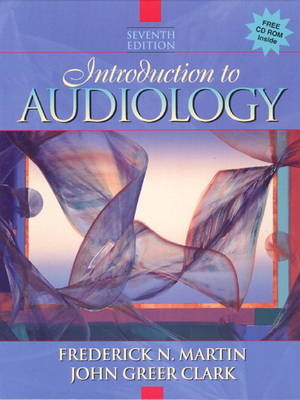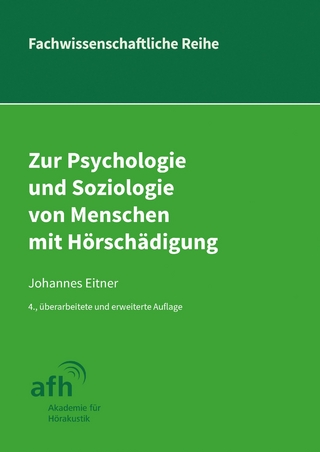
Introduction to Audiology
Pearson (Verlag)
978-0-205-29536-4 (ISBN)
- Titel erscheint in neuer Auflage
- Artikel merken
This is a major revision of the leading text for the introduction to hearing and hearing disorders course required of all SLP/A majors. Known for its in-depth coverage of the physics of sound, anatomy and physiology of the auditory system, causes and treatment of hearing disorders, and the relevant diagnostic and therapeutic techniques, Introduction to Audiology is now augmented by an instructional CD-ROM.
The accompanying CD-ROM features visual and auditory demonstrations, samples of audiograms representing different kinds of hearing loss, different sound stimuli, and filtered speech to simulate sensorineural hearing loss. It also includes an extensive literature section with useful forms, addresses of organizations, publishers, lists of books of special interest, and much more.
Each chapter includes “Chapter Objectives,” “Summary,” “Study Questions,” “Glossary,” “References,” and “Suggested Readings.” I.ELEMENTS OF AUDIOLOGY.
1.The Profession of Audiology.
The Evolution of Audiology.
Prevalence and Impact of Hearing Loss.
Audiology Specialties.
Medical Audiology.
Educational Audiology.
Pediatric Audiology.
Dispensing/Rehabilitative Audiology.
Industrial Audiology.
Professional Societies.
2.The Human Ear and Simple Tests of Hearing.
Anatomy and Physiology of the Ear.
Pathways of Sound.
Types of Hearing Loss.
Hearing Tests.
Tuning Fork Tests.
3.Sound and Its Measurement.
Sound.
Waves.
Vibrations.
Frequency.
Resonance.
Sound Velocity.
Wavelength.
Phase.
Intensity.
The Decibel.
Complex Sounds.
Impedance.
Sound Measurement.
Environmental Sounds.
Psychoacoustics.
II.HEARING ASSESSMENT.
4.Pure-Tone Audiometry.
The Pure-Tone Audiometer.
Test Environment.
The Patient's Role in Manual Pure-Tone Audiometry.
The Clinician's Role in Manual Pure-Tone Audiometry.
Air-Conduction Audiometry.
Bone-Conduction Audiometry.
Audiogram Interpretation.
Masking.
The Audiometric Weber Test.
Automatic Audiometry.
Computerized Audiometry.
5.Speech Audiometry.
The Diagnostic Audiometer.
Test Environment.
The Patient's Role in Speech Audiometry.
The Clinician's Role in Speech Audiometry.
Speech-Threshold Testing.
Masking for SRT.
Bone-Conduction SRT.
Most Comfortable Loudness Level.
Uncomfortable Loudness Level.
Range of Comfortable Loudness.
Word-Recognition Testing.
Computerized Speech Audiometry.
6.Electrophysiological Tests.
Acoustic Immittance.
Acoustic Reflexes.
Auditory Evoked Potentials.
Otoacoustic Emissions (OAE).
7.Behavioral Tests for Site of Lesion.
Loudness Recruitment.
Implication of Loudness Recruitment.
The Short Increment Sensitivity Index.
Tone Decay.
Békésky Audiometry.
8.Hearing Tests for Children.
Auditory Responses.
Identifying Hearing Loss in Infants under Three Months of Age.
Testing Children from Birth to Approximately One Year of Age.
Testing Children Approximately One to Five Years of Age.
Language Disorders.
Central Auditory Processing Disorders.
Psychological Disorders.
Developmental Disabilities.
Identifying Hearing Loss in the Schools.
Nonorganic Hearing Loss in Children.
III.HEARING DISORDERS.
9.The Outer Ear.
Anatomy and Physiology of the Outer Ear.
Development of the Outer Ear.
Hearing Loss and the Outer Ear.
Disorders of the Outer Ear and Their Treatments.
10.The Middle Ear.
Anatomy and Physiology of the Middle Ear.
Development of the Middle Ear.
Hearing Loss and the Middle Ear.
Disorders of the Middle Ear and Their Treatments.
Other Causes of Middle-Ear Hearing Loss.
11.The Inner Ear.
Anatomy and Physiology of the Inner Ear.
Development of the Inner Ear.
Hearing Loss and the Inner Ear.
Causes of Inner-Ear Disorders.
12.The Auditory Nerve and Central Auditory Pathways.
Anatomy and Physiology of the Auditory Nerve and Ascending Auditory Pathways.
The Descending Auditory Pathways.
Development of the Auditory Nerve and Central Auditory Nervous System.
Summary of the Auditory Pathways.
Hearing Loss and the Auditory Nerve and Central Auditory Pathways.
Disorders of the Auditory Nerve.
Disorders of the Cochlear Nuclei.
Disorders of the Higher Auditory Disorders.
Tests for Central Auditory Disorders.
Diagnostic Limitations.
Therapeutic Management.
13.Nonorganic Hearing Loss.
Terminology.
Patients with Nonorganic Hearing Loss.
Tests for Nonorganic Hearing Loss.
Electrophysiological Tests.
Other Confusion Tests.
Management of Patients with Nonorganic Hearing Loss.
IV.MANAGEMENT OF HEARING LOSS.
14.Amplification/Sensory Systems.
Hearing Aid Development.
Hearing Aid Circuit Overview.
Characteristics of Hearing Aids.
Binaural Amplification.
Types of Hearing Aids.
Selecting Hearing-Aid Candidates.
Selecting Hearing Aids for Adults.
Selecting Hearing Aids for Children.
Dispensing Hearing Aids.
Verifying Hearing Aid Performance.
Hearing Assistance Technologies.
15.Audiological (Re)Habilitation.
Patient Histories.
Referral to Other Specialists.
Management of Adults with Hearing Impairments.
Management of Children with Hearing Impairments.
Management of Tinnitus.
Hyperacusis.
Multicultural Consideration.
Author Index.
Subject Index.
| Erscheint lt. Verlag | 29.9.1999 |
|---|---|
| Sprache | englisch |
| Maße | 197 x 243 mm |
| Gewicht | 945 g |
| Themenwelt | Medizin / Pharmazie ► Medizinische Fachgebiete ► HNO-Heilkunde |
| ISBN-10 | 0-205-29536-3 / 0205295363 |
| ISBN-13 | 978-0-205-29536-4 / 9780205295364 |
| Zustand | Neuware |
| Haben Sie eine Frage zum Produkt? |
aus dem Bereich


